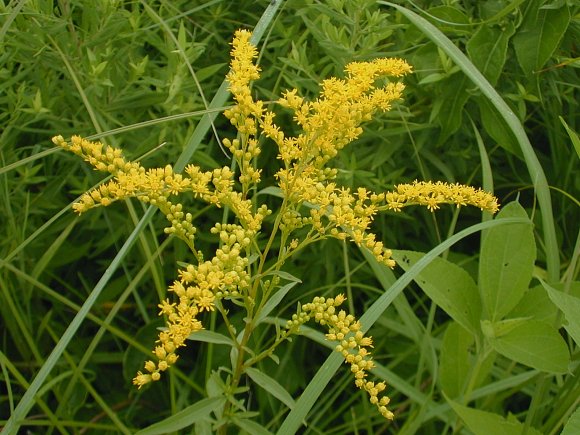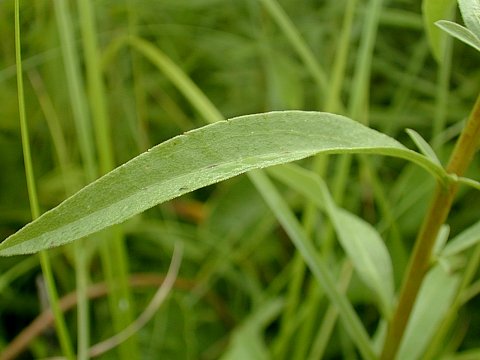Description: This herbaceous perennial plant is unbranched and up to 3' tall. The central stem is slightly ridged, hairless, and green or reddish. The alternate leaves are up to 8" long and 1½" across, becoming much smaller as they ascend up the stem. They are lanceolate, oblanceolate, or narrowly ovate, while their margins are smooth or slightly serrated. Sometimes there are tiny hairs along the margins, otherwise the leaves are hairless. The leaves are sessile or taper gradually to a petiole-like base. Above their axils along the central stem are small wing-like leaflets. The inflorescence occurs at the apex of the plant, and consists of a panicle of flowering stems that often arch upward and outward like a fireworks display. There are numerous yellow composite flowers, each about ¼" across. From 4 to 12 ray florets can be observed around the disk florets, often unevenly spaced and not open at the same time. The flowers may have a mild fragrance. The blooming period occurs during mid- to late summer, and lasts about 1 to 1½ months. Later, the achenes develop with small tufts of hair, which are dispersed by wind. The root system consists of a short caudex (on old plants), which may produce rhizomes and vegetative offshoots.

Cultivation:
The
preference is full to partial sun, and mesic to slightly dry
conditions. Moist conditions are tolerated, if the soil is reasonably
well-drained. This plant is not fussy about soil texture, which can
contain loam, clay, sand, or gravel. Foliar disease is not normally a
problem until after the blooming period, when mildew and other diseases
may appear.
Range & Habitat:
The native Early Goldenrod is widely distributed throughout Illinois,
occurring in
most counties (see Distribution
Map). It is occasional to locally common. Early Goldenrod
occurs in mesic to slightly dry black soil prairies, sand prairies,
gravel prairies, oak savannas, thickets, open areas of rocky upland
woods, sunny waste areas, and abandoned fields. It is the earliest
goldenrod to bloom in these habitats in Illinois.

Faunal Associations: Like other goldenrods, this plant attracts many kinds of insects to the flowers, including long-tongued and short-tongued bees, wasps, flies, butterflies, moths, and beetles, including Chauliognathus pennsylvanicus (Goldenrod Soldier Beetle). The larvae of many moths feed on the foliage and other parts of this goldenrod (see Moth Table), while the adults of Cirrhophanus triangulifer (Goldenrod Stowaway Moth) like to hide in the flowers. Other insects feed on this and other goldenrods, including various lace bugs, leafhoppers, seed beetles, leaf beetles, and Lygus lineolaris (Tarnished Plant Bug). The Greater Prairie Chicken may feed on the foliage, while the Eastern Goldfinch, Tree Sparrow, and Swamp Sparrow eat the seeds to a limited extent. Mammalian herbivores may feed on the foliage if little else is available, including the White-Tailed Deer, Groundhog, Cottontail Rabbit, and livestock.

Photographic
Location:
The photographs were taken at Loda Cemetery Prairie in Iroquois County,
Illinois.
Comments:
This is the earliest blooming goldenrod. It is an attractive, slender
plant with a delicate appearance. Aside from its early bloom, Early
Goldenrod can be distinguished from other goldenrods by the near or
complete absence of hair on the stems and leaves (unlike Solidago
nemoralis), the presence of winged leaflets above the leaf
axils on the central stem (unlike Solidago canadensis),
and an inflorescence that flares outward (rather than upward, like Solidago
speciosa). No other goldenrod that occurs on prairies in
Illinois has this combination of features.